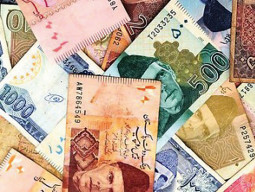
Pakistan’s current account deficit in the first 10 months of 2014-15 remained $1.3 billion, according to data released by the State Bank of Pakistan (SBP) on Monday.
The current account deficit shrank by $1.5 billion in July-April compared to the same 10-month period of the preceding fiscal year when it was $2.9 billion. The decrease is partly attributable to the Coalition Support Fund (CSF), as Pakistan received $717 million in the second week of February.
A deficit or surplus reflects whether a country is a net borrower or lender of capital with respect to the rest of the world.
As a percentage of the gross domestic product (GDP), the current account deficit stood at 0.6% in July-April as opposed to 1.4% for the same period of 2013-14.
In April alone, the current account balance remained in surplus: it amounted to $275 million as opposed to a current account deficit of $20 million in March. The notable change in the current account balance is because of a sharp reduction in the value of goods imported.
On a month-on-month basis, the value of goods imported decreased to $2.9 billion in April. From imports of goods valuing $3.3 billion in March, the month-on-month decrease remained 9.6% in April.
Pakistan’s total imports of goods in July-April were $34 billion as opposed to $34.5 billion in the comparable period of 2013-14, which means an annual decrease of 1.5%.
Pakistan exported goods worth over $20.1 billion in July-April as opposed to exports of goods totalling $20.8 billion in the comparable months of 2013-14, reflecting a year-on-year decrease of 3.1%.

The value of goods exported in April increased by $8 million on a month-on-month basis to a little over $2 billion, which is 0.4% higher than the exports of goods recorded in March.
Total oil imports constitute roughly 36% of Pakistan’s total import bill. According to Topline Securities, a 30% decline in oil prices is likely to result in annual savings of $4 billion or 1.5% of GDP. As a result, Pakistan is likely to witness current account surplus in 2015-16, it says. The balance of trade in both goods and services at the end of the first 10 months of 2014-15 clocked up at -$15.5 billion as opposed to the deficit of $16.1 billion recorded in the same period of the preceding fiscal year.
Workers’ remittances remained $14.9 billion in July-April, up 16% from the same 10 months of the last fiscal year when they totalled $12.8 billion. Workers’ remittances in April clocked up at $1.6 billion, registering an increase of 3.9% on a month-on-month basis.
Published in The Express Tribune, May 19th, 2015.
Like Business on Facebook, follow @TribuneBiz on Twitter to stay informed and join in the conversation.















1710998259-0/pti-(1)1710998259-0-270x192.webp)


























COMMENTS (5)
Comments are moderated and generally will be posted if they are on-topic and not abusive.
For more information, please see our Comments FAQ